Information Technologies for Real-Time Mapping of Human Well-Being Indicators in an Urban Historical Garden
Abstract
:1. Introduction
1.1. Comfort Indicators
1.2. Modelling Direct/Diffuse Solar Radiation
2. Materials and Methods
2.1. Study Area
2.2. Sensors and Geopositioning
2.3. Data Flow and Storage
2.4. 3D Models
2.4.1. Laser Scanning Survey
2.4.2. Digital Terrain Model
2.4.3. Shadow-Casting Model
2.5. Comfort Indices Calculation
- Sleeping: 0.7 met, (41 W/m2)
- Reclining: 0.8 met, (47 W/m2)
- Seated, quiet, reading, writing: 1.0 (58.2 W/m2)
- Typing: 1.1 met, (64 W/m2)
- Standing, relaxed, seated: 1.2 (70 W/m2)
- Walking slowly: 1.4 met, (81 W/m2)
- Driving a car: 1.5 met, (87 W/m2)
- Walking at a medium speed: 1.7 met, (99 W/m2)
- Walking at 2 mph (3.2 km/h): 2.0 met, (116 W/m2)
- Light machine work: 2.2 met, (128 W/m2)
- Walking at 3 mph (4.8 km/h): 2.6 met, (151 W/m2)
- House cleaning: 2.7 met, (157 W/m2)
- Driving, heavy vehicle: 3.2 met, (186 W/m2)
- Dancing: 3.4 met, (198 W/m2)
- Walking at 4 mph (6.4 km/h): 3.8 met, (221 W/m2)
- Heavy machine work: 4.0 met, (233 W/m2)
2.6. Shadow-Casting Estimation
2.7. R Package and Webapp
3. Results
3.1. Webapp
3.2. Sensors Comparison
4. Discussion
5. Conclusions
- vectorize the R code to provide better performance for PET calculation. PET calculation iterates to find the optimal energy balance, but this requires an average of 20 iterations for each process;
- use PostgreSQL libraries optimized for big data, such as TimescaleDB. Up to now, we have data from three months and in a single historical garden, but to foresee storage of data from more IoT devices to replicate this process in other gardens, it must be noted that better solutions based on sharding and distributed data have to be implemented;
- continue ongoing collaboration with research teams that study human well-being, which will foster new applications across disciplines.
Supplementary Materials
Author Contributions
Funding
Data Availability Statement
Conflicts of Interest
References
- Pirotti, F.; Piragnolo, M.; Guarnieri, A.; Boscaro, M.; Cavalli, R. Analysis of Geospatial Behaviour of Visitors of Urban Gardens: Is Positioning via Smartphones a Valid Solution? In Geomatics and Geospatial Technologies; Borgogno-Mondino, E., Zamperlin, P., Eds.; Springer International Publishing: Cham, Switzerland, 2022; pp. 351–365. ISBN 978-3-030-94426-1. [Google Scholar]
- Carbone, E.; Palumbo, R.; Sella, E.; Lenti, G.; Di Domenico, A.; Borella, E. Emotional, Psychological, and Cognitive Changes Throughout the COVID-19 Pandemic in Italy: Is There an Advantage of Being an Older Adult? Front. Aging Neurosci. 2021, 13, 712369. [Google Scholar] [CrossRef] [PubMed]
- Höppe, P. Temperatures of expired air under varying climatic conditions. Int. J. Biometeorol. 1981, 25, 127–132. [Google Scholar] [CrossRef] [PubMed]
- Gagge, A.P.; Stolwijk, J.A.J.; Nishi, Y. An Effective Temperature Scale Based on a Simple Model of Human Physiological Regulatiry Response. SHRAE Trans. 1971, 77, 247–257. [Google Scholar]
- Höppe, P.R. Heat balance modelling. Experientia 1993, 49, 741–746. [Google Scholar] [CrossRef]
- Höppe, P. The physiological equivalent temperature—A universal index for the biometeorological assessment of the thermal environment. Int. J. Biometeorol. 1999, 43, 71–75. [Google Scholar] [CrossRef]
- Gagge, A.P.; Fobelets, A.P.; Berglund, L.G. A standard predictive Index of human reponse to thermal enviroment. Am. Soc. Heat. Refrig. Air-Cond. Eng. 1986, 92, 709–731. [Google Scholar]
- Fanger, P.O. Thermal Comfort. Analysis and Applications in Environmental Engineering; Danish Technical Press: København, Denmark, 1970. [Google Scholar]
- Matzarakis, A.; Rutz, F.; Mayer, H. Modelling radiation fluxes in simple and complex environments—Application of the RayMan model. Int. J. Biometeorol. 2007, 51, 323–334. [Google Scholar] [CrossRef]
- Matzarakis, A.; Rutz, F.; Mayer, H. Modelling radiation fluxes in simple and complex environments: Basics of the RayMan model. Int. J. Biometeorol. 2010, 54, 131–139. [Google Scholar] [CrossRef]
- Nyamgeroh, B.B.; Groen, T.A.; Weir, M.J.C.; Dimov, P.; Zlatanov, T. Detection of forest canopy gaps from very high resolution aerial images. Ecol. Indic. 2018, 95, 629–636. [Google Scholar] [CrossRef]
- Smith, M.-L.; Anderson, J.; Fladeland, M. Forest Canopy Structural Properties. In Field Measurements for Forest Carbon Monitoring: A Landscape-Scale Approach; Hoover, C.M., Ed.; Springer: Dordrecht, The Netherlands, 2008; pp. 179–196. ISBN 978-1-4020-8506-2. [Google Scholar]
- Kuusk, A.; Pisek, J.; Lang, M.; Märdla, S. Estimation of gap fraction and foliage clumping in forest canopies. Remote Sens. 2018, 10, 1153. [Google Scholar] [CrossRef]
- Glatthorn, J.; Beckschäfer, P. Standardizing the protocol for hemispherical photographs: Accuracy assessment of binarization algorithms. PLoS ONE 2014, 9, e111924. [Google Scholar] [CrossRef] [PubMed]
- Pereira, R.; Zweede, J.; Asner, G.P.; Keller, M. Forest canopy damage and recovery in reduced-impact and conventional selective logging in eastern Para, Brazil. For. Ecol. Manag. 2002, 168, 77–89. [Google Scholar] [CrossRef]
- Xiong, Y.; Zhang, J.; Xu, X.; Yan, Y.; Sun, S.; Liu, S. Strategies for improving the microclimate and thermal comfort of a classical Chinese garden in the hot-summer and cold-winter zone. Energy Build. 2020, 215, 109914. [Google Scholar] [CrossRef]
- Xue, S.; Xiao, Y. Study on the Outdoor Thermal Comfort Threshold of Lingnan Garden in Summer. Procedia Eng. 2016, 169, 422–430. [Google Scholar] [CrossRef]
- Zong, H.; Liu, Y.; Wang, Q.; Liu, M.L.; Chen, H. Usage patterns and comfort of gardens: A seasonal survey of internal garden microclimate in the aged care homes of Chengdu City. Int. J. Biometeorol. 2019, 63, 1181–1192. [Google Scholar] [CrossRef] [PubMed]
- Pirotti, F.; Piragnolo, M.; Vettore, A.; Guarnieri, A. Comparing accuracy of ultra-dense laser scanner and photogrammetry point clouds. Int. Arch. Photogramm. Remote Sens. Spat. Inf. Sci. 2022, 43, 353–359. [Google Scholar] [CrossRef]
- Axelsson, P. DEM Generation from laser scanner data using adaptive TIN models. Int. Arch. Photogramm. Remote Sens. Spat. Inf. Sci. 2000, 33, 110–117. [Google Scholar]
- Walther, E.; Goestchel, Q. The P.E.T. comfort index: Questioning the model. Build. Environ. 2018, 137, 1–10. [Google Scholar] [CrossRef]
- Di Napoli, C.; Hogan, R.J.; Pappenberger, F. Mean radiant temperature from global-scale numerical weather prediction models. Int. J. Biometeorol. 2020, 64, 1233–1245. [Google Scholar] [CrossRef]
- Di Napoli, C.; Barnard, C.; Prudhomme, C.; Cloke, H.L.; Pappenberger, F. ERA5-HEAT: A global gridded historical dataset of human thermal comfort indices from climate reanalysis. Geosci. Data J. 2021, 8, 2–10. [Google Scholar] [CrossRef]
- Dimiceli, V.E.; Piltz, S.F.; Amburn, S.A. Black globe temperature estimate for the WBGT index. In IAENG Transactions on Engineering Technologies; Springer: Berlin/Heidelberg, Germany, 2013; pp. 323–334. [Google Scholar]
- Dimiceli, V.E.; Piltz, S.F.; Amburn, S.A. Estimation of Black Globe Temperature for Calculation of the Wet Bulb Globe Temperature Index. In Proceedings of the World Congress on Engineering and Computer Science, San Francisco, CA, USA, 19–21 October 2011; Volume II. [Google Scholar]
- Pebesma, E.J.; Bivand, R.S. Classes and Methods for Spatial Data in R. Available online: https://geobgu.xyz/r-2019/resources/Rnews_2005-2.pdf (accessed on 20 September 2022).
- Pirotti, F.; Kobal, M.; Roussel, J.R. A Comparison of Tree Segmentation Methods Using Very High Density Airborne Laser Scanner Data. Int. Arch. Photogramm. Remote Sens. Spat. Inf. Sci. 2017, XLII-2/W7, 285–290. [Google Scholar] [CrossRef]
- The Imaging and Geospatial Information Society. ASPRS The American Society for Photogrammetry & Remote Sensing LAS Specification Version 1.4-R13. Available online: Ttps://www.asprs.org/wp-content/uploads/2010/12/LAS_1_4_r13.pdf (accessed on 22 September 2021).
- Hijmans, R.J. Terra: Spatial Data Analysis 2022. Available online: https://cran.r-project.org/web/packages/terra/index.html (accessed on 22 September 2021).
- Morgan-Wall, T. rayshader: Create Maps and Visualize Data in 2D and 3D 2022. Available online: https://cran.r-project.org/web/packages/rayshader/index.html (accessed on 22 September 2021).
- Prataviera, E.; Romano, P.; Carnieletto, L.; Pirotti, F.; Vivian, J.; Zarrella, A. EUReCA: An open-source Urban Building Energy Modeling tool for the efficient evaluation of cities energy demand. Renew. Energy 2021, 173, 544–560. [Google Scholar] [CrossRef]
- Cetin, M.; Adiguzel, F.; Kaya, O.; Sahap, A. Mapping of bioclimatic comfort for potential planning using GIS in Aydin. Environ. Dev. Sustain. 2018, 20, 361–375. [Google Scholar] [CrossRef]
- Oka, M. The Influence of Urban Street Characteristics on Pedestrian Heat Comfort Levels in Philadelphia. Trans. GIS 2011, 15, 109–123. [Google Scholar] [CrossRef]
- Kántor, N.; Unger, J. The most problematic variable in the course of human-biometeorological comfort assessment—The mean radiant temperature. Cent. Eur. J. Geosci. 2011, 3, 90–100. [Google Scholar] [CrossRef]
- Schweiker, M.; Mueller, S. comf: Models and Equations for Human Comfort Research 2022. Available online: https://search.r-project.org/CRAN/refmans/comf/html/comf-package.html (accessed on 22 September 2021).
- Dyvia, H.A.; Arif, C. Analysis of thermal comfort with predicted mean vote (PMV) index using artificial neural network. IOP Conf. Ser. Earth Environ. Sci. 2021, 622, 012019. [Google Scholar] [CrossRef]
- Freitas, S.; Catita, C.; Redweik, P.; Brito, M.C. Modelling solar potential in the urban environment: State-of-the-art review. Renew. Sustain. Energy Rev. 2015, 41, 915–931. [Google Scholar] [CrossRef]
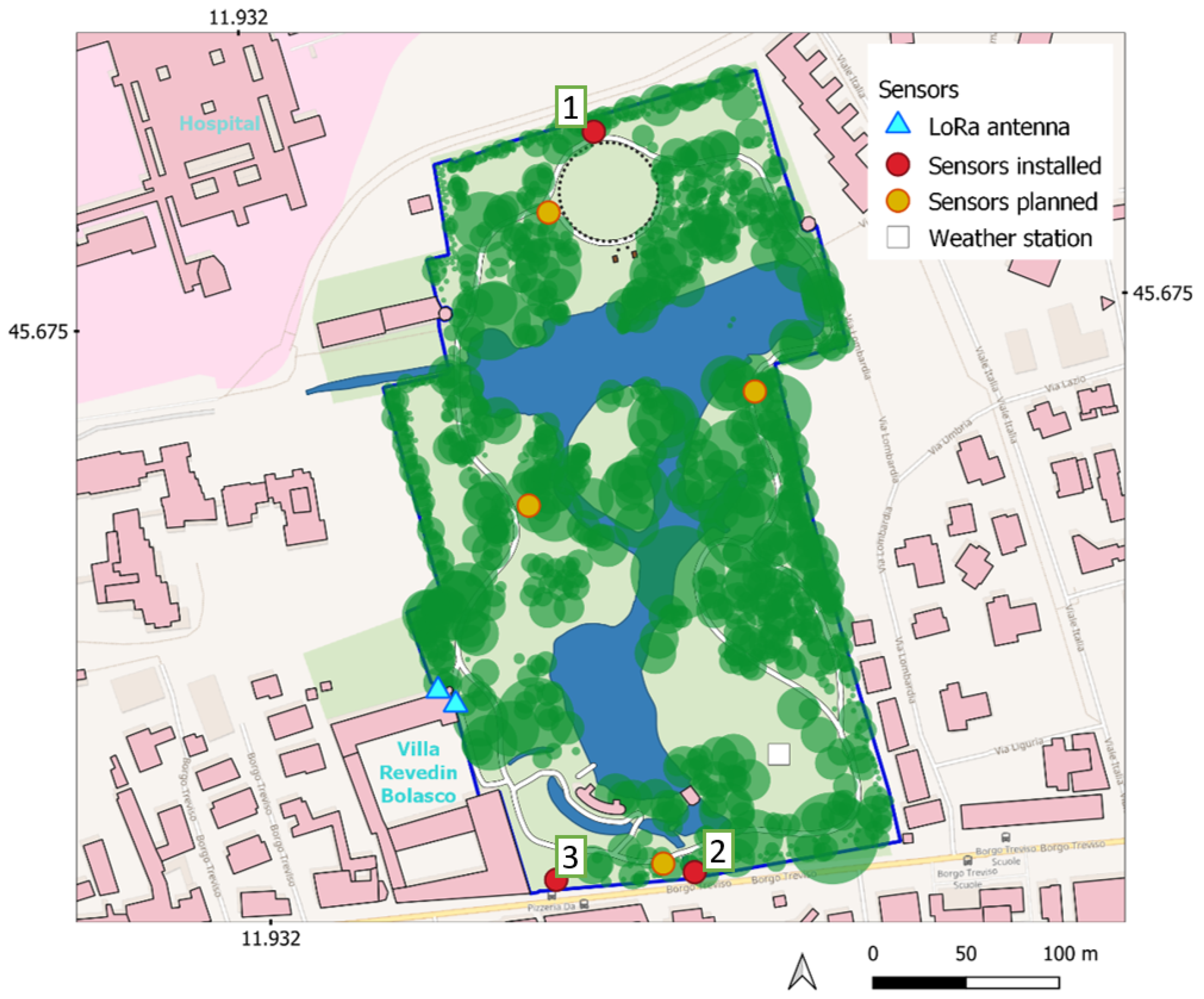


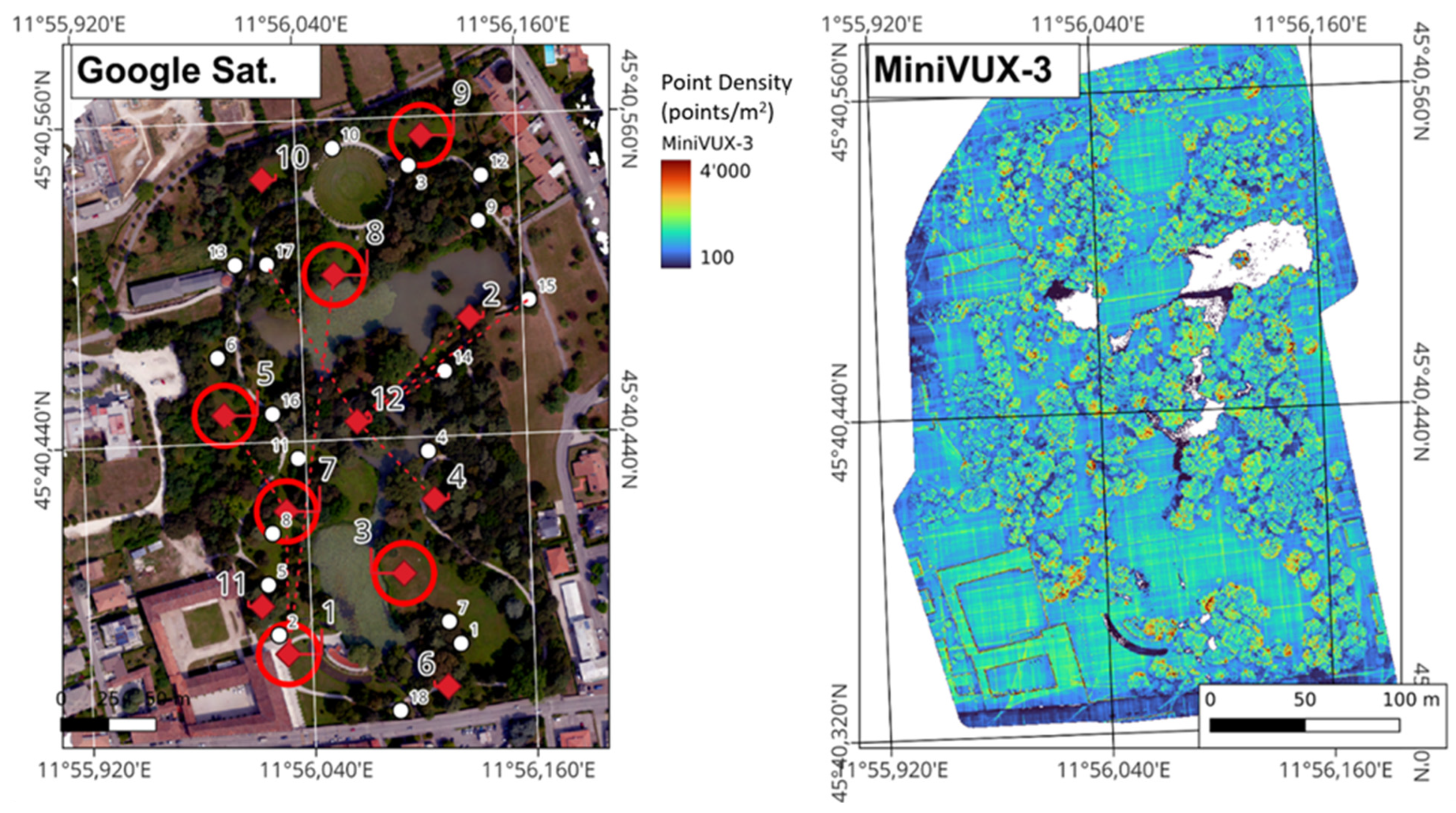
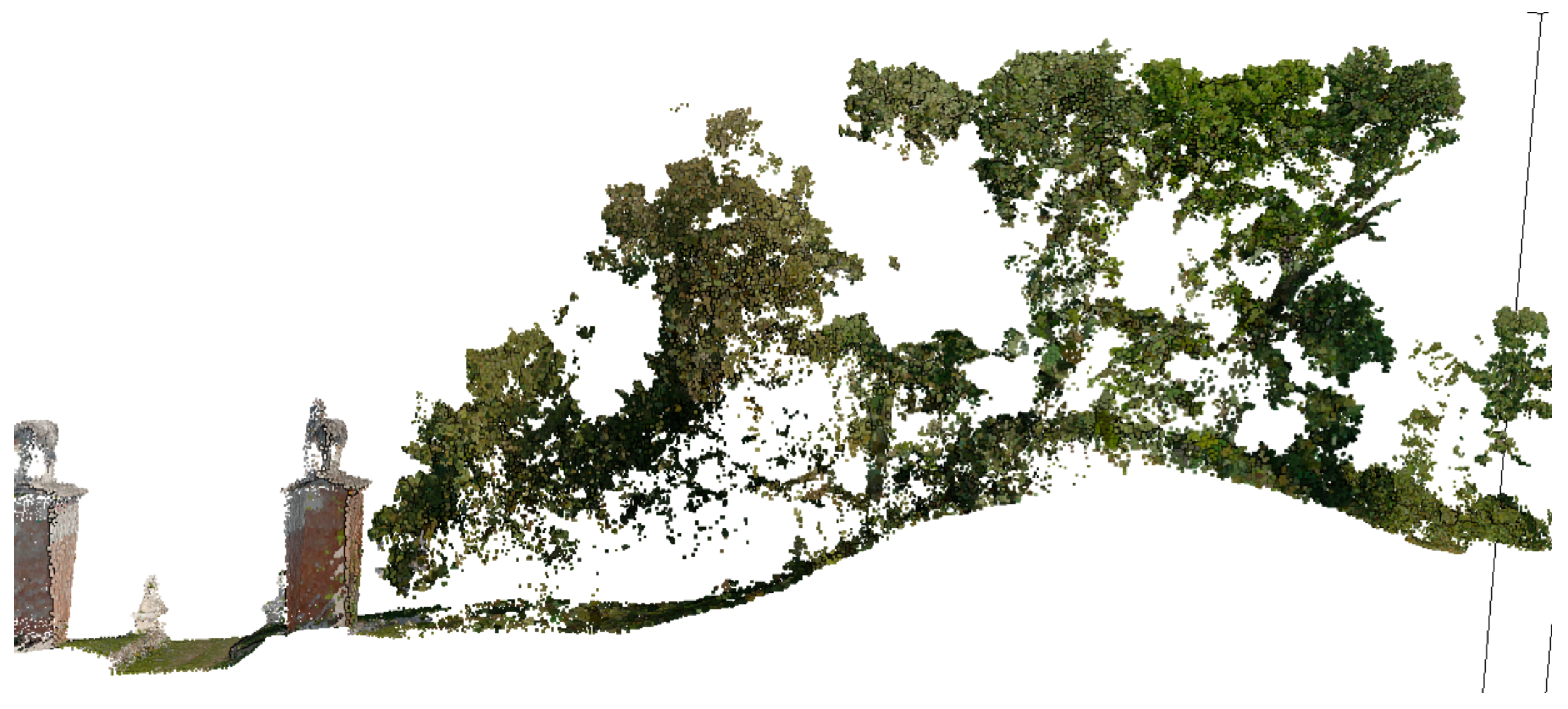
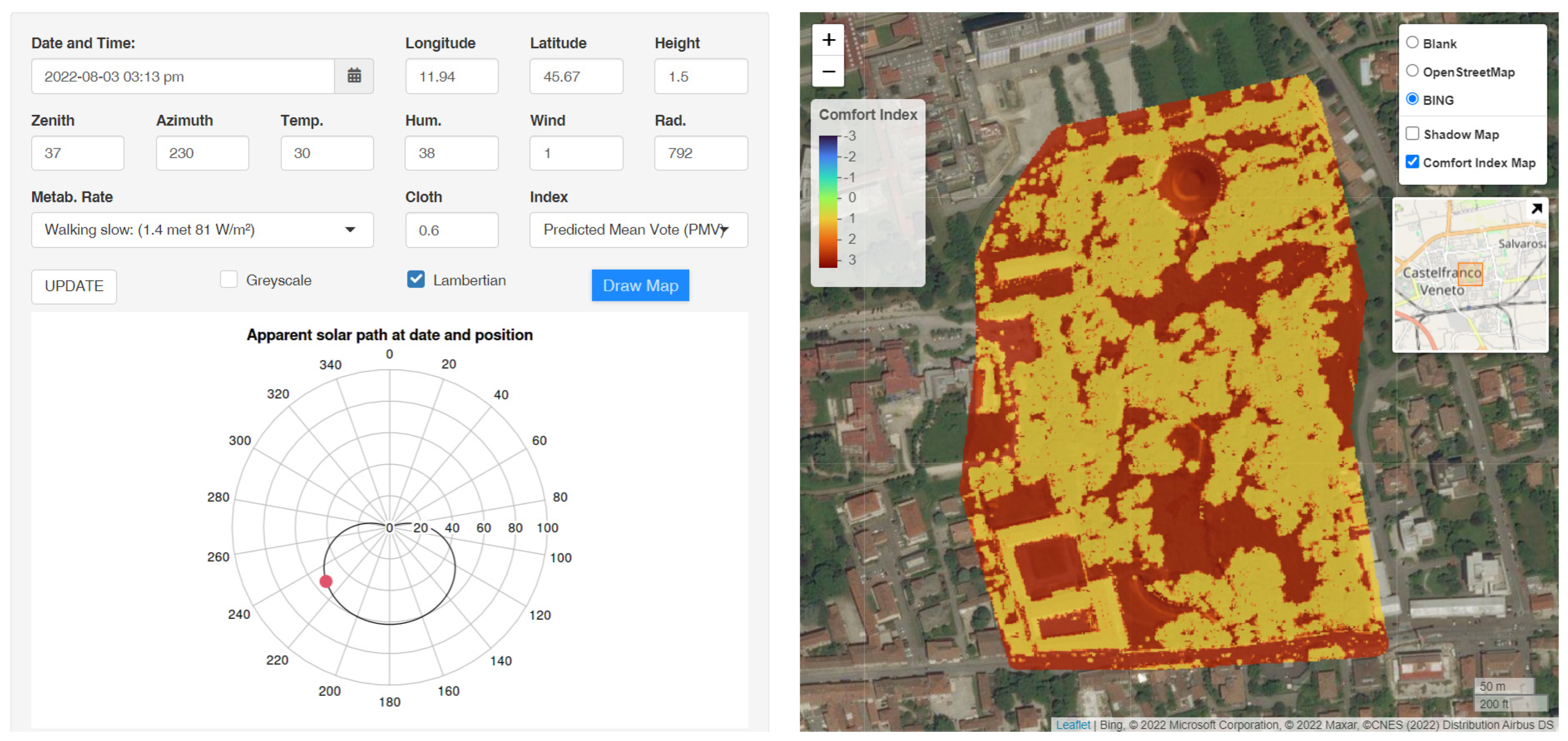
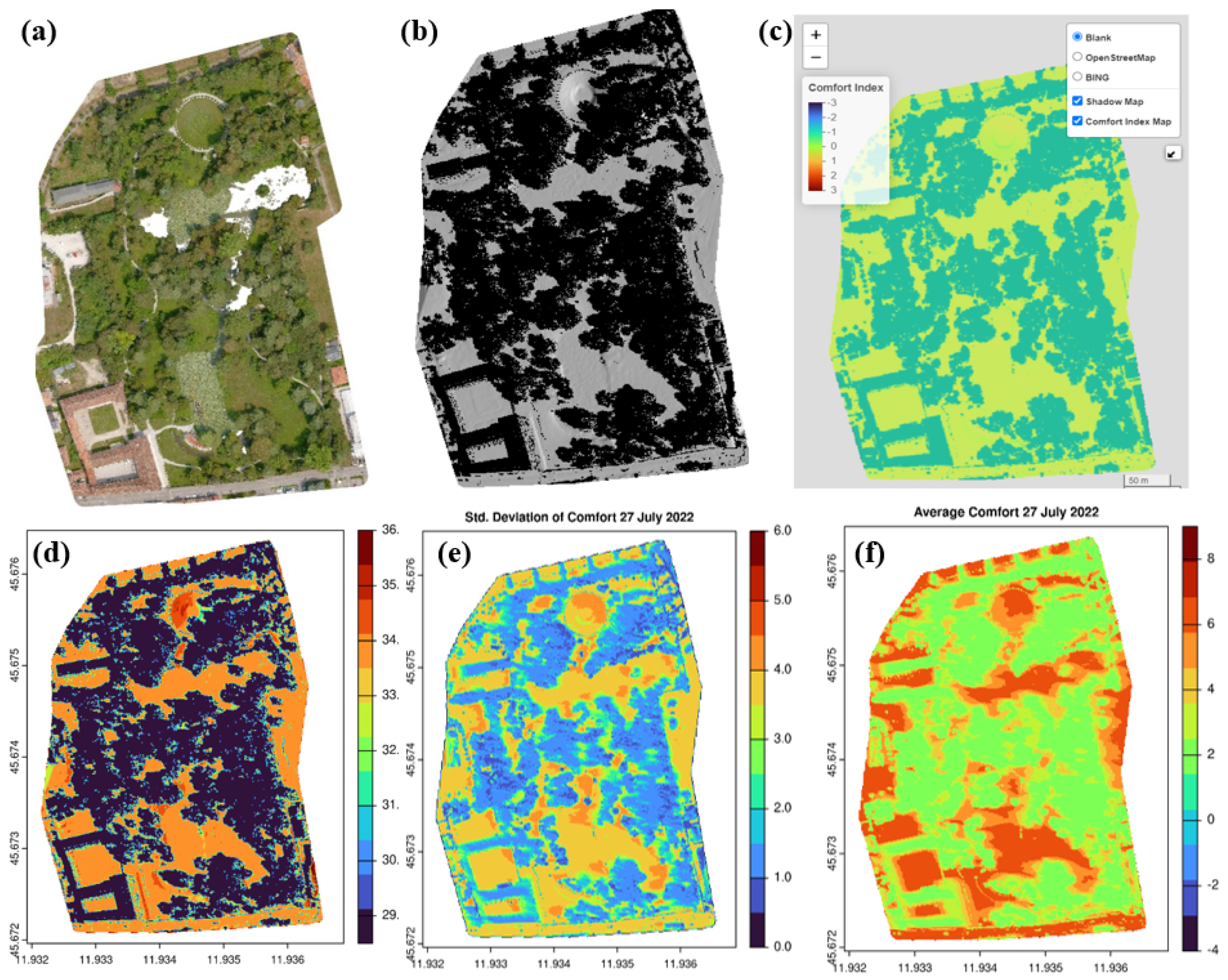


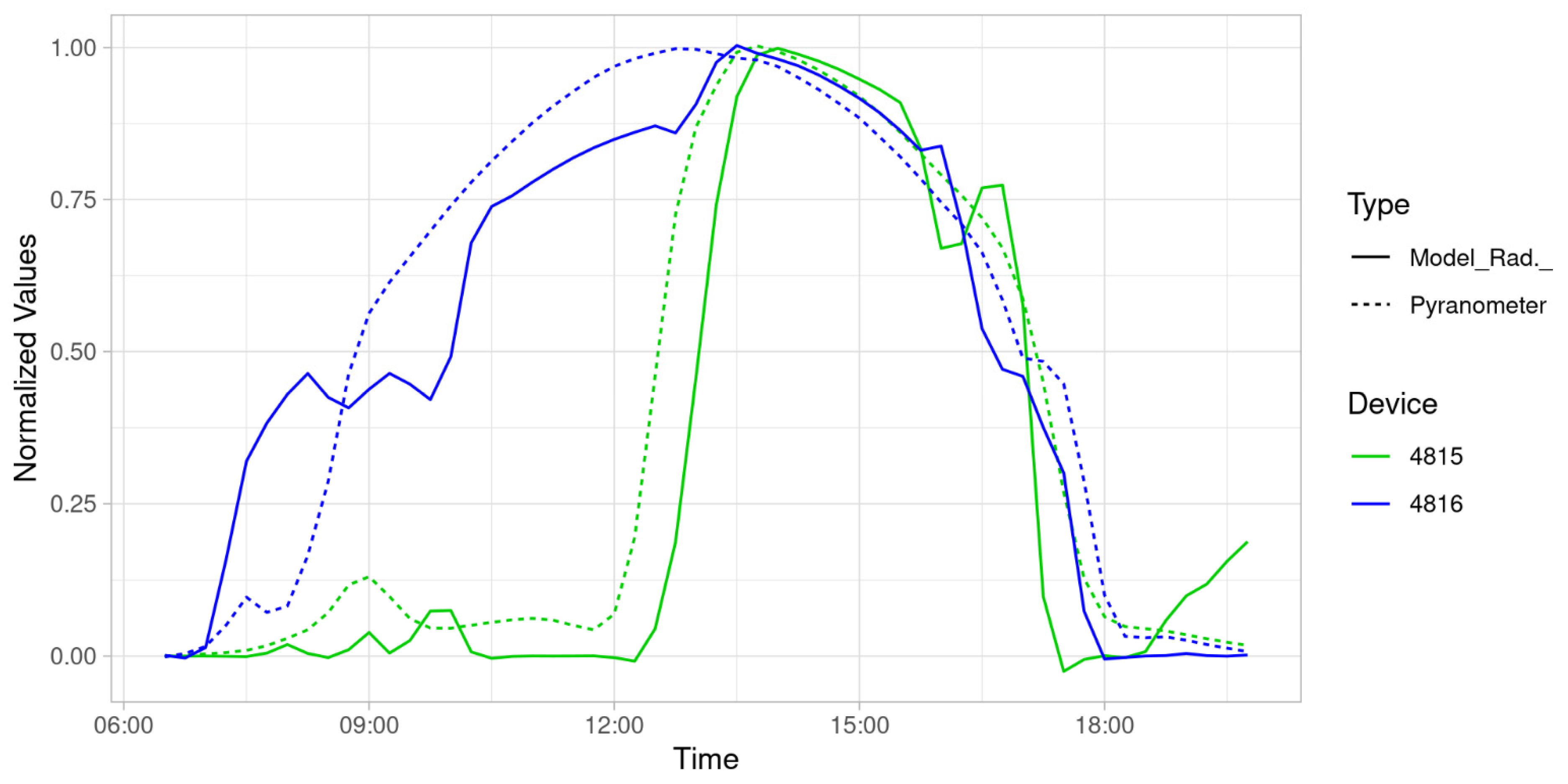
| Make, Model, (Abbreviation) | Sensors | N. |
|---|---|---|
| Synetica enLink Air-X (Syn-Air) | temperature, relative humidity, barometric pressure, ozone, oxygen, carbon dioxide, nitrogen dioxide, volatile organic compounds (VOC), and particles as PM 1, 2.5, 4, 10 (quality measurement) | 3 |
| DecentLab DL_ATM22 (DL-Atm) | temperature and wind speed and direction vectors | 3 |
| DecentLab DL_PYR (DL-Pyr) | pyranometers for measuring solar radiation | 7 |
| Iotsens Sound Level (Iot-Snd) | noise level | 3 |
| Davis Pro weather station (DP-Wst) | temperature, barometric pressure, humidity, rainfall, solar and UV radiation, wind speed, and wind direction | 1 |
| Sensedge Senstick (Sen-Stk) | temperature, humidity, and acceleration | 10 |
Publisher’s Note: MDPI stays neutral with regard to jurisdictional claims in published maps and institutional affiliations. |
© 2022 by the authors. Licensee MDPI, Basel, Switzerland. This article is an open access article distributed under the terms and conditions of the Creative Commons Attribution (CC BY) license (https://creativecommons.org/licenses/by/4.0/).
Share and Cite
Pirotti, F.; Piragnolo, M.; D’Agostini, M.; Cavalli, R. Information Technologies for Real-Time Mapping of Human Well-Being Indicators in an Urban Historical Garden. Future Internet 2022, 14, 280. https://doi.org/10.3390/fi14100280
Pirotti F, Piragnolo M, D’Agostini M, Cavalli R. Information Technologies for Real-Time Mapping of Human Well-Being Indicators in an Urban Historical Garden. Future Internet. 2022; 14(10):280. https://doi.org/10.3390/fi14100280
Chicago/Turabian StylePirotti, Francesco, Marco Piragnolo, Marika D’Agostini, and Raffaele Cavalli. 2022. "Information Technologies for Real-Time Mapping of Human Well-Being Indicators in an Urban Historical Garden" Future Internet 14, no. 10: 280. https://doi.org/10.3390/fi14100280
APA StylePirotti, F., Piragnolo, M., D’Agostini, M., & Cavalli, R. (2022). Information Technologies for Real-Time Mapping of Human Well-Being Indicators in an Urban Historical Garden. Future Internet, 14(10), 280. https://doi.org/10.3390/fi14100280









